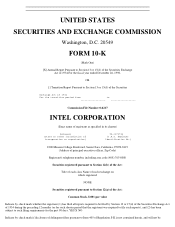Intel 1998 Annual Report Download - page 6
Download and view the complete annual report
Please find page 6 of the 1998 Intel annual report below. You can navigate through the pages in the report by either clicking on the pages listed below, or by using the keyword search tool below to find specific information within the annual report.realism for Internet applications. The Pentium III processor core, which is based on Intel's P6 microarchitecture, includes Internet Streaming
SIMD Extensions--70 new instructions that enhance the performance of advanced imaging, 3-
D, streaming audio, video and speech recognition
applications. The 450- and 500-MHz versions, with 512 KB L2 cache, began shipping in March and the 550-MHz version is expected to be
available in the second quarter of 1999. In March 1999, Intel announced the Intel Pentium III Xeon microprocessor, targeted to enhance
Internet software and application performance for the mid-range to high-
performance server and workstation market segments. The Pentium III
Xeon is initially being offered at a speed of 500 MHz, available in 512 KB, 1 MB and 2 MB L2 cache versions for two-, four- and eight-way
(and higher) servers and workstations.
The Company's family of 64-bit microprocessors under development is expected to expand the capabilities of the Intel architecture to address
the high-performance server and workstation market segments while still running the software that currently operates on the 32-bit Intel
processor-based machines. A 64-bit microprocessor is more complex than a 32-bit microprocessor and requires a more complex system
architecture, but it handles twice as much data on each clock cycle. Intel has been working with industry leaders to help them develop operating
systems, applications software and systems that will capitalize on the new IA-64 architecture. The first processor in Intel's IA-64 product
family, the Merced processor, is expected to be available to OEMs in sample volumes in 1999 and initial production volumes in mid-2000.
While many of Intel's OEM customers use the Company's microprocessors as components in designing their own computer products, some
OEMs use Intel-designed board-level products as basic building blocks in their computer products. OEM customers may buy at this level of
integration to accelerate their time-to-market and to direct their investments to other areas of their product lines. The Company provides board-
level products to give OEM customers flexibility by enabling them to choose whether to buy at the component or board level. Board-level
products based on Intel's new microprocessors were introduced simultaneously with each corresponding microprocessor product in 1998.
COMPUTING ENHANCEMENT GROUP
Intel's Computing Enhancement Group's products include chipsets; embedded processors, including Pentium processors with MMX technology
and StrongARM -Registered Trademark- processors; microcontrollers; flash memory products; and graphics products.
CHIPSETS. The Company's core-logic chipsets support incremental performance, ease of use and new capabilities for systems based on the
Intel Celeron, Pentium II, Pentium III and Pentium II Xeon microprocessors. Chipsets perform essential logic functions surrounding the central
processing unit and support and extend the graphics, video and other capabilities of many Intel processor-based systems. The Company's
chipsets are compatible with a variety of industry-standard buses, such as the Peripheral Components Interconnect
("PCI") Local Bus specification and the Accelerated Graphics Port ("AGP")
specification. A bus is a circuit that carries data between parts of the system, for example, between the processor and main memory. Revenues
from sales of chipsets represented a majority of revenues for the Computing Enhancement Group operating segment in 1998.
To help enable computer makers to speed their products to market, chipsets are introduced along with the corresponding processors. In April
1998, the 440EX was introduced as the first AGPset designed specifically for Intel's Celeron processor and targets the value PC market
segment. The Company introduced the 440BX AGPset in August 1998, optimizing Pentium II processor performance for 3-D and video
applications with a 100-MHz system bus. With the June 1998 announcement of the Pentium II Xeon processor, the Company introduced two
chipsets. The Intel 440GX AGPset provides 2 GB-memory support for workstations and for servers with one or two processors. The Intel
450NX PCIset for servers with four or more processors provides up to 8 GB-memory support and multiple 32-bit and 64-bit PCI buses.
EMBEDDED PRODUCTS. The Computing Enhancement Group provides embedded products such as microprocessors, microcontrollers and
memory components to a wide range of OEMs who use the Company's embedded products in a variety of applications, including
telecommunications, printers, hubs, routers, wide area networking, intelligent input/output, imaging, storage media, keyboards, point-of-sale
terminals and automotive systems.
4



















